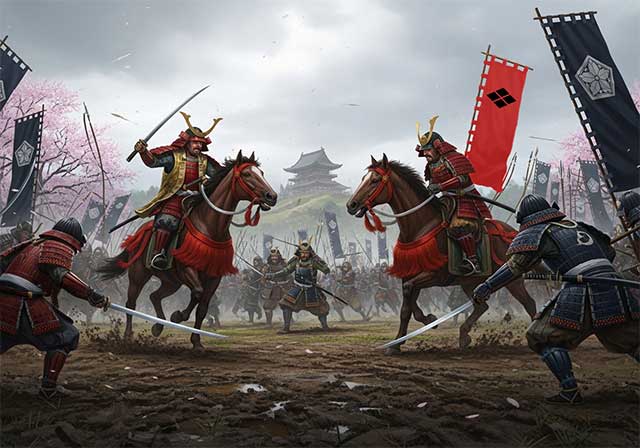
As a result of the summer campaign of 1542, the Suwa clan was completely defeated. Takeda Shingen stationed his military contingent at Uehara Castle. Takeda's army general, Itagaki Nobukata, subsequently became the commandant of this castle.
Uehara was to become an important outpost in the conquered lands. Itagaki eagerly set about rebuilding the castle and even built himself a residence within its fortifications.
Allies and division of lands
Takeda's ally in the war against the Suwa clan was Takato Yoritsugu. His contribution to the victory was significant, and according to the alliance treaty, he was given the lands west of the Miyagawa River. The Takeda clan came to rule the lands east of it.
The division was fair, but it did not satisfy Yoritsugu. Relations between the clans began to deteriorate.
Search for allies and rebellion
Takato Yoritsugu could not stand up to Takeda's military machine alone, so he began to look for allies. He managed to win over Yajima Mitsukiyo, Aruga Totomi-no-kami, and Fujisawa Yoritsugu from the Ina region. In addition, Yoritsugu requested support from the Harutika region.
On September 10, Takato's troops attacked Uehara Castle. The castle was taken, and Takeda's troops were forced to leave the Suwa region.
Shingen reacted swiftly. By September 19, Takeda's army had crossed the border with Suwa and set up camp near the Sakai River. The Kohakusai-ki source claims that the vanguard of Takeda's army, led by Itagaki Nobukata, was already in Suwa on September 11. This may indicate that Shingen, thanks to his developed spy network, knew about the impending uprising and was ready to act immediately.
The political aspect of the campaign
The political side of the campaign is of particular interest. Shingen's family raised the son of the defeated Suwa Yorishige, Torao. He was considered the legitimate heir to the Suwa lands.
Thus, Shingen went on a campaign on his behalf, legitimizing the campaign against Takato. He also informed the former vassals of the Suwa clan that he was acting on behalf of Suwa Torao, and this bore fruit: former Suwa vassals began to flock to Takeda's camp.
He was joined by Moria Yorizane (Yorimasa), Suwa Mitsutaka, and representatives of the Tino, Yajima, and Kosaka clans. Yorishige's uncle, Suwa Mitsutaka, decided to oppose Takato from his castle in Takashima.
Takato Yoritsugu found himself in a difficult position, and a clash became inevitable.
The Battle of Ankoku-ji
On September 25, a battle took place near the Miyagawa River, which went down in history as the Battle of Ankoku-ji, named after a nearby temple.
According to some sources, Takeda Shingen had only a few thousand soldiers, although he had the capacity to recruit up to twenty thousand men. Yoritsugu commanded an army of two thousand men.
The battle began at two o'clock in the afternoon and lasted almost four hours. Takeda's troops pressed the enemy, and finally Takato gave the signal to retreat.
It is believed that Yoritsugu himself nearly died in battle, but managed to escape through the Tsuezuki Pass to his castle in Takato. His army lost 700 men killed. Yoritsugu's younger brother, Takato Yorimune, was killed.
Yajima Mitsukiyo lost his son in battle and became a fugitive himself, wandering for a long time as a ronin, trying not to be caught by Takeda's patrols. It is believed that Takeda's army lost only 50 men. If the figures are correct, then Shingen won a brilliant victory.
Autumn campaign
The battle of Ankoku-ji did not end the campaign against Takato. Part of Takeda's army followed the retreating enemy through the Tsuezuki Pass.
On September 26, Komai Masataka's troops, led by Moria Yorizane's scouts (shinobi), invaded the Ina region. They ravaged the lands around Fukuyo Castle and laid siege to the fortress.
The castle commander, Fujisawa Yoritsugu, defended himself in the hope that Takato Yoritsugu would come to his aid. But after several days of siege, he surrendered. However, he was not punished and even retained Fukuyo Castle.
Conquest of the Ina region
Other Takeda generals also crossed the pass and invaded the Ina region. Among them was Itagaki Nobukata, who arrived there three days after Komai.
His troops ravaged several villages and moved towards the Aruga Pass. Itagaki searched for traces of the remnants of Takato's army and, satisfied that the resistance had been broken, returned to Kai Province. Komai also left the region.
Results of the campaign
After Takeda's victory in the autumn campaign, the Suwa region remained completely under his control. Part of the Ina region was also captured, but Shingen decided to focus on the lands he had already conquered.
Itagaki Nobukata was appointed chief administrator of the Suwa region, based at Uehara Castle.
The castle reconstruction project began in May 1543 and was completed in April of the following year. Uehara controlled an important crossroads, guarded the approaches to the “home” province of Kai, and served as a convenient springboard for future conquests.
See also
-
The Siege of Hara Castle

The Shimabara Rebellion of 1637–1638, which culminated in the siege of Hara Castle, was the last major uprising of the Edo period and had serious political consequences.
-
Battle of Tennoji

The confrontation between Tokugawa Ieyasu and Toyotomi Hideyori during the “Osaka Winter Campaign” ended with the signing of a peace treaty. On January 22, 1615, the day after the treaty was signed, Ieyasu pretended to disband his army. In reality, this meant that the Shimazu forces withdrew to the nearest port. On the same day, almost the entire Tokugawa army began filling in the outer moat.
-
Siege of Shuri Castle

The Ryukyu Kingdom was established in 1429 on Okinawa, the largest island of the Ryukyu (Nansei) archipelago, as a result of the military unification of three rival kingdoms. In the following years, the state's control spread to all the islands of the archipelago.
-
The Siege of Fushimi Castle
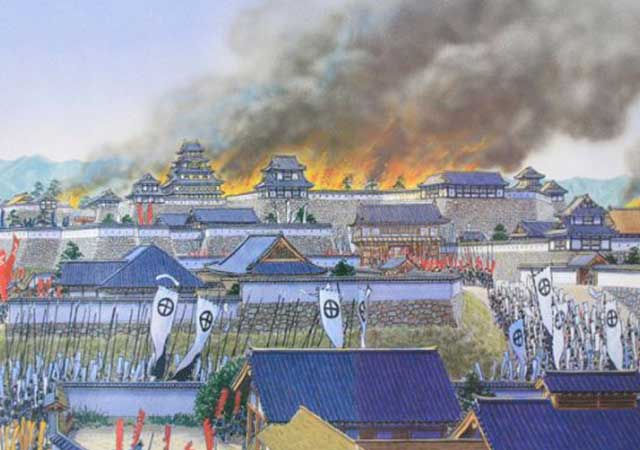
Fushimi can perhaps be considered one of the most “unfortunate” castles of the Sengoku Jidai period. The original castle was built by Toyotomi Hideyoshi in the southeast of Kyoto in 1594 as his residence in the imperial city.
-
The Siege of Otsu Castle
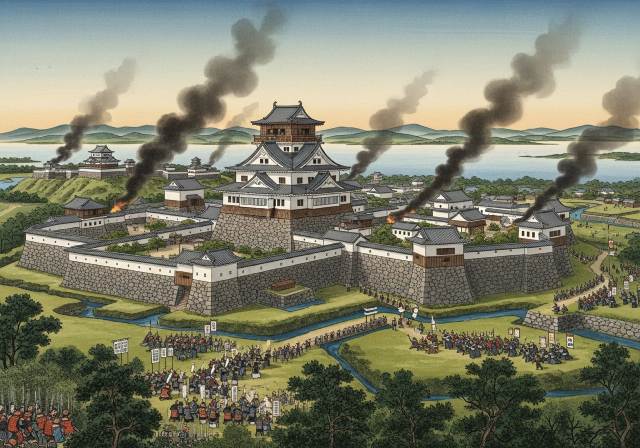
The siege of Otsu Castle was part of the Sekigahara campaign, during which the so-called Eastern Coalition, led by Tokugawa Ieyasu, fought against the Western Coalition, led by Ishida Mitsunari. Otsu Castle was built in 1586 by order of Toyotomi Hideyoshi near the capital Kyoto, on the site of the dismantled Sakamoto Castle. It belonged to the type of “water castles” — mizujō — as one side of it faced Japan's largest lake, Lake Biwa, and it was surrounded by a system of moats filled with lake water, which made the fortress resemble an island.
-
The Siege of Shiroishi Castle
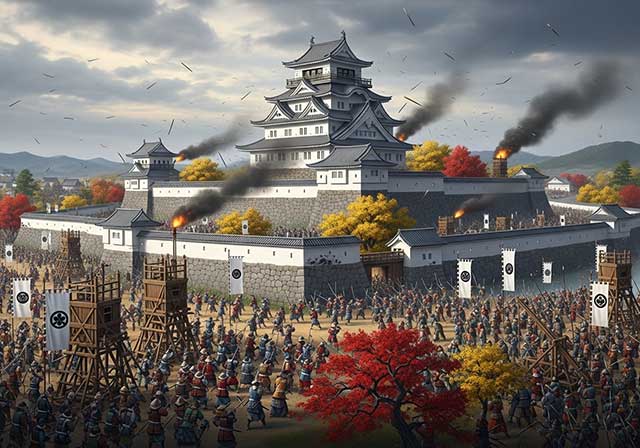
The siege of Shiroishi Castle was part of the Sekigahara campaign and took place several months before the decisive battle of Sekigahara. The daimyo of Aizu Province, Uesugi Kagekatsu, posed a serious threat to Tokugawa Ieyasu's plans to defeat the Western Coalition, and Ieyasu decided to curb his actions with the help of his northern vassals. To this end, he ordered Date Masamune to invade the province of Aizu and capture Shiroishi Castle.
-
The Second Siege of Jinju Castle
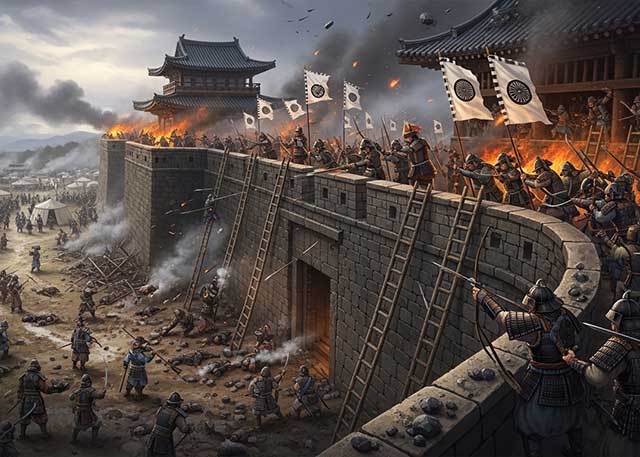
During the two Korean campaigns of the 16th century, the Japanese repeatedly had to capture enemy fortresses and defend occupied or constructed fortifications from the combined Korean and Chinese forces. Among all the operations of that time, the second siege of Jinju Castle is considered the most interesting from the point of view of siege warfare.
-
The Siege of Takamatsu Castle
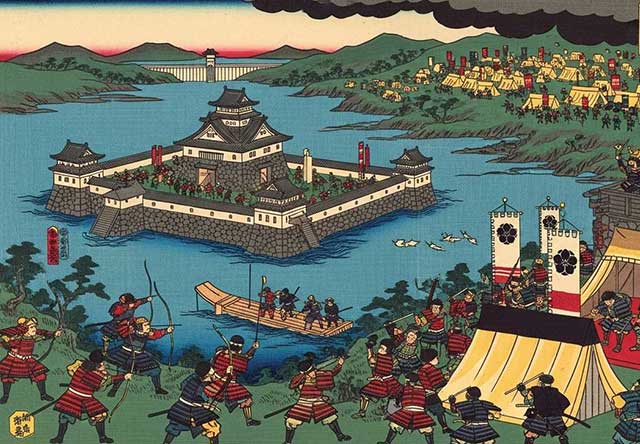
The siege of Takamatsu Castle in Bitchu Province is considered the first mizuzeme, or “water siege,” in Japanese history. Until then, such an original tactic had never been used.

